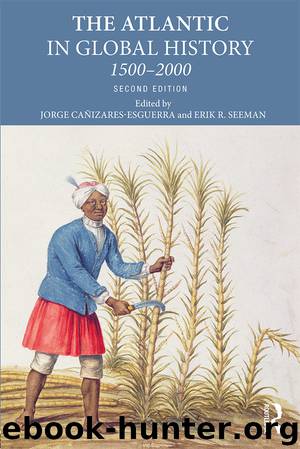The Atlantic in Global History by Jorge Canizares-Esguerra Erik R Seeman

Author:Jorge Canizares-Esguerra,Erik R Seeman
Language: eng
Format: epub
Publisher: Taylor & Francis (CAM)
Published: 2017-08-05T04:00:00+00:00
From this jumping-off point in Bengal in the 1790s, it was but a small step for European (and Asian) merchant capitalists either to set up rice export platforms or to reconfigure existing platforms in adjacent areas of Southeast Asia: first on Java, then in Tenasserim and Arakan (“the granary of the Bay of Bengal”), and a bit later in Lower Burma more generally and Siam and Cochin China. Within decades—well before the American Civil War, U.S. historians should note—South and Southeast Asian exporting areas had knocked the South Carolina–Georgia rice region out of its most important markets, beginning the long-term, spiraling fall of the region into economic oblivion. At the same time, other Western exporters—Italy most notably—were rendered irrelevant even as the Western rice market grew exponentially as a result of a complicated (and intercorrelated) mélange of factors—rising income per capita, urbanization, and industrialization among them. Indeed, given the uses to which rice was put in the West, the proletarianization of much of the European labor force as well as the expansion of the slave labor force in parts of the Americas (Cuba, for example) helps explain the surge in demand for rice as well. Interestingly enough, in a way the “Western” market for rice was growing dramatically in Asia at the same time as European interests (particularly British and Dutch) established mining and plantation-crop zones in places such as Malaya and Sumatra, zones that quickly became heavily dependent on imported rice.39
By the late nineteenth century, the domination of world rice markets by Asian suppliers was virtually complete, as several powerful developments in transport and communications—the rise of steamshipping, the opening of the Suez Canal, and the laying of the transoceanic cable, most notably—rendered the region’s significant competitive advantages greater still. Not surprisingly, the challenge posed by Asian exports wreaked havoc on Western rice suppliers even as cheap Asian rice helped keep Western factories humming and Western bellies full. This is not to say that Western rice interests sat on their hands, though. The rise of the West had not been achieved through inertia and inaction, and, when confronted with what must have seemed to some an inexorable, perhaps inevitable process and to others as a cataclysmic shock, rice interests mobilized and for the most part responded robustly, if with only mixed success, at least at first. Tariff barriers against Asian imports were erected virtually everywhere, and the geography of rice production shifted dramatically: in the United States from the Southeast to Louisiana, Texas, Arkansas, and, a bit later, California and in Brazil from the northeast southward to Rio, São Paulo, and eventually Rio Grande do Sul, for example. The geographic shift coincided with—indeed, in large part was driven by—new production technology as producers strove furiously to find a way to drive down costs or, failing at that, to find other ways to survive the Asian onslaught. Over time, producers in some parts of the West were able to do just that, and by the 1920s a radically different rice industry had emerged in such areas.
Download
This site does not store any files on its server. We only index and link to content provided by other sites. Please contact the content providers to delete copyright contents if any and email us, we'll remove relevant links or contents immediately.
| Africa | Americas |
| Arctic & Antarctica | Asia |
| Australia & Oceania | Europe |
| Middle East | Russia |
| United States | World |
| Ancient Civilizations | Military |
| Historical Study & Educational Resources |
Cat's cradle by Kurt Vonnegut(15114)
Pimp by Iceberg Slim(14236)
4 3 2 1: A Novel by Paul Auster(12235)
Underground: A Human History of the Worlds Beneath Our Feet by Will Hunt(11986)
The Radium Girls by Kate Moore(11877)
Wiseguy by Nicholas Pileggi(5618)
Perfect Rhythm by Jae(5283)
American History Stories, Volume III (Yesterday's Classics) by Pratt Mara L(5218)
The Fire Next Time by James Baldwin(5207)
Paper Towns by Green John(5031)
Pale Blue Dot by Carl Sagan(4867)
A Higher Loyalty: Truth, Lies, and Leadership by James Comey(4803)
The Mayflower and the Pilgrims' New World by Nathaniel Philbrick(4383)
The Doomsday Machine by Daniel Ellsberg(4380)
Killers of the Flower Moon: The Osage Murders and the Birth of the FBI by David Grann(4355)
The Sympathizer by Viet Thanh Nguyen(4269)
Too Much and Not the Mood by Durga Chew-Bose(4237)
The Borden Murders by Sarah Miller(4197)
Sticky Fingers by Joe Hagan(4071)
